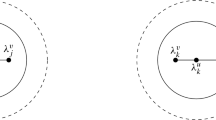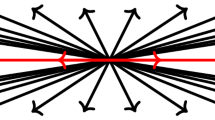Abstract
We study two integrable systems associated with the coupled NLS equation: the integrable defect system and the integrable boundary systems. Regarding the first one, we present a type I defect condition, which is described by a Bäcklund transformation frozen at the defect location. For the resulting defect system, we prove its integrability both by showing the existence of an infinite set of conserved quantities and by implementing the classical r-matrix method. Regarding the second one, we present some new integrable boundary conditions for the coupled NLS equation by imposing suitable reductions on the defect conditions. Our new boundary conditions, unlike the usual boundary conditions (such as the Robin boundary), involve time derivatives of the coupled NLS fields and are characterised by non constant \(K(\lambda )\) matrices. We prove the integrability of our new boundary conditions by using Sklyanin’s approach.
Similar content being viewed by others
References
Avan, J., Doikou, A.: Liouville integrable defects: the non-linear Schrödinger paradigm. J. High Energ. Phys. 2012, 40 (2012)
Avan, J., Caudrelier, V., Doikou, A., Kundu, A.: Lagrangian and Hamiltonian structures in an integrable hierarchy and space-time duality. Nucl. Phys. B 902, 415–439 (2016)
Avan, J., Caudrelier, V., Crampé, N.: From Hamiltonian to zero curvature formulation for classical integrable boundary conditions. J. Phys. A 51, 30LT01 (2018)
Bowcock, P., Corrigan, E., Zambon, C.: Classically integrable field theories with defects. Int. J. Mod. Phys. A 19, 82–91 (2004)
Bowcock, P., Corrigan, E., Zambon, C.: Affine Toda field theories with defects. J. High Energ. Phys. 2004, 056 (2004)
Busch, T., Anglin, J.R.: Dark-bright solitons in inhomogeneous Bose-Einstein condensates. Phys. Rev. Lett. 87, 010401 (2001)
Caudrelier, V.: On a systematic approach to defects in classical integrable field theories. Int. J. Geom. Meth. Mod. Phys. 5(7), 1085 (2008)
Caudrelier, V., Kundu, A.: A multisymplectic approach to defects in integrable classical field theory. J. High Energ. Phys. 02, 088 (2015)
Caudrelier, V., Stoppato, M.: A connection between the classical \(r\)-matrix formalism and covariant Hamiltonian field theory. J. Geom. Phys. 148, 103546 (2020)
Caudrelier, V., Zhang, C.: The vector nonlinear Schrödinger equation on the half-line. J. Phys. A: Math. Theor. 45(10), 105201 (2012)
Caudrelier, V., Crampe, N., Dibaya, C.M.: Nonlinear mirror image method for nonlinear Schrödinger equation: Absorption/emission of one soliton by a boundary. Stud. Appl. Math. 148, 715–757 (2022)
Corrigan, E., Zambon, C.: Jump-defects in the nonlinear Schrödinger model and other non-relativistic field theories. Nonlinearity 19, 1447 (2006)
Corrigan, E., Zambon, C.: A new class of integrable defects. J. Phys. A 42, 475203 (2009)
Doikou, A.: Classical impurities associated to high rank algebras. Nucl. Phys. B 884, 142 (2014)
Doikou, A.: Classical integrable defects as quasi Bäcklund transformations. Nucl. Phys. B 911, 212 (2016)
Doikou, A., Fioravanti, D., Ravanini, F.: The generalized non-linear Schrödinger model on the interval. Nuclear Phys. B 790, 465–492 (2008)
Faddeev, L.D., Takhtajan, L.A.: Hamiltonian Methods in the Theory of Solitons. Springer, Berlin (2007)
Gruner, K.T.: Dressing a new integrable boundary of the nonlinear Schrödinger equation, arXiv preprint arXiv:2008.03272 (2020)
Gruner, K.T.: Soliton solutions of the nonlinear Schrödinger equation with defect conditions. Nonlinearity 34, 6017 (2021)
Gu, C.H., Hu, H.S., Zhou, Z.X.: Darboux Transformations in Integrable Systems: Theory and Their Applications. Springer, Berlin (2005)
Habibullin, I.T.: The Bäcklund transformation and integrable initial boundary value problems. Matematicheskie Zametki 49(4), 130–137 (1991)
Habibullin, I., Kundu, A.: Quantum and classical integrable sine-Gordon model with defect. Nucl. Phys. B 795, 549 (2008)
Kodama, Y.: Theory of canonical transformations for nonlinear evolution equations II. Prog. Theo. Phys. 57, 1900–1916 (1977)
Kodama, Y., Wadati, M.: Theory of canonical transformations for nonlinear evolution equations. I. Prog. Theo. Phys. 56, 1740–1755 (1976)
Manakov, S.V.: On the theory of two-dimensional stationary self focussing of electromagnetic waves. Soviet Phys. JETP 38, 248–253 (1974)
Sklyanin, E.K.: Boundary conditions for integrable equations. Funct. Anal. Appl. 21(2), 164–166 (1987)
Wright, O.C.: The Darboux Transformation of Some Manakov Systems. Appl. Math. Lett. 16, 647–652 (2003)
Xia, B.: On the nonlinear Schrödinger equation with a boundary condition involving a time derivative of the field. J. Phys. A: Math. Theor. 54, 165202 (2021)
Zambon, C.: The classical nonlinear Schrödinger model with a new integrable boundary. J. High Energ. Phys. 2014, 36 (2014)
Zhang, C.: On the inverse scattering transform for the nonlinear Schrödinger equation on the half-line, arXiv preprint arXiv:2106.02336, (2021)
Zhang, C., Zhang, D.: Vector NLS solitons interacting with a boundary. Commun. Theor. Phys. 73(4), 045005 (2021)
Zhou, R., Li, P., Gao, Y.: Equal-Time and Equal-Space Poisson Brackets of the N-Component Coupled NLS Equation. Commun. Theor. Phys. 67, 347–349 (2017)
Acknowledgements
The author would like to express his sincerest gratitude to the referees for their valuable comments, which have helped him to improve this paper. This work was supported by the National Natural Science Foundation of China (Grant No. 11771186) and 333 Project of Jiangsu Province (No. BRA2020246).
Author information
Authors and Affiliations
Corresponding author
Additional information
Communicated by Robert Buckingham.
Publisher's Note
Springer Nature remains neutral with regard to jurisdictional claims in published maps and institutional affiliations.
Rights and permissions
About this article
Cite this article
Xia, B. A Type I Defect and New Integrable Boundary Conditions for the Coupled Nonlinear Schrödinger Equation. J Nonlinear Sci 32, 53 (2022). https://doi.org/10.1007/s00332-022-09809-6
Received:
Accepted:
Published:
DOI: https://doi.org/10.1007/s00332-022-09809-6




